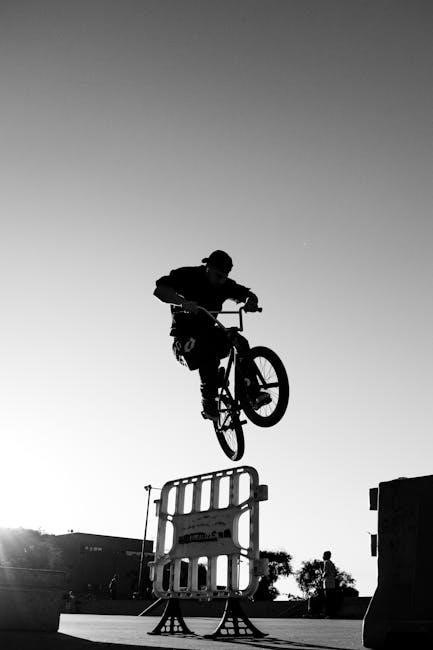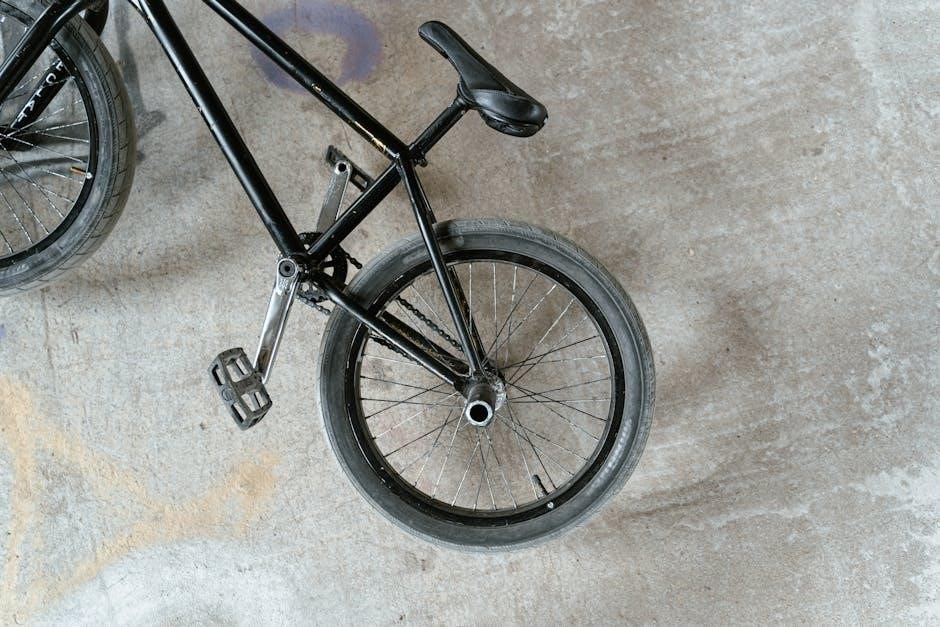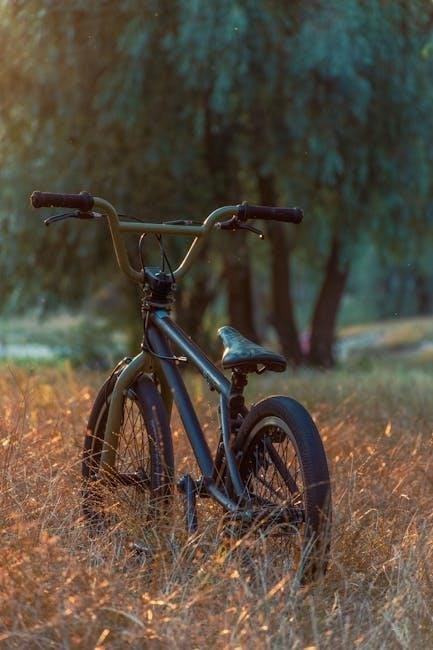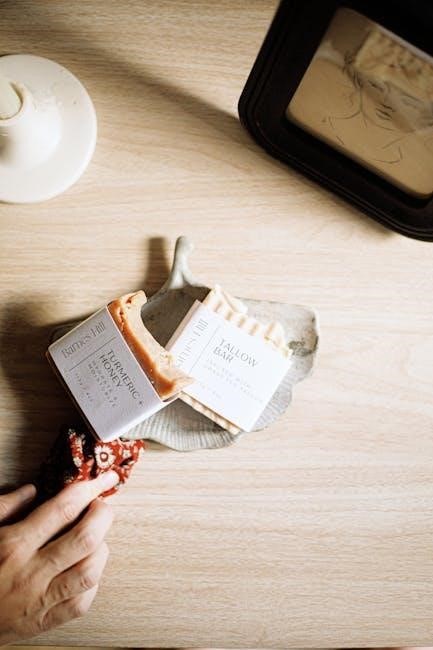
bmx frame size guide
Understanding BMX Frame Size
Understanding BMX frame size is crucial for optimal control and comfort. The top tube length determines the bike’s fit, correlating with the rider’s height for ideal performance and stability.
Key Factors Influencing Frame Size
Several factors influence BMX frame size, including rider height, wheel size, and riding style. Rider height is a primary determinant, as it ensures optimal comfort and control. Wheel size also plays a role, with standard 20-inch wheels suiting most riders, while smaller or larger wheels cater to specific needs. Riding style is another critical factor—freestyle riders may prefer different frame proportions compared to racers. Additionally, top tube length and crank length are important, as they affect maneuverability and clearance. Understanding these elements helps in selecting the right frame size for enhanced performance and personal preference.
Importance of Top Tube Measurement
The top tube measurement is a critical factor in determining BMX frame size. It directly impacts the rider’s comfort and control by setting the distance between the handlebars and the seat. A longer top tube provides more room for taller riders, while a shorter one suits smaller frames. Proper top tube length ensures the bars are within easy reach, optimizing stability and maneuverability. This measurement is essential for both racing and freestyle riding, as it affects how the bike handles. Ensuring the top tube aligns with the rider’s body proportions enhances performance and reduces fatigue, making it a key consideration in choosing the right BMX bike.
BMX Bike Wheel Size Guide
The wheel size significantly affects a BMX bike’s performance. Standard 20-inch wheels are common for racing and tricks, while sizes range from 12 to 26 inches.
Standard Wheel Sizes and Their Uses
Standard BMX wheel sizes range from 12 to 26 inches, catering to different rider needs. The most common size is 20 inches, used for racing and freestyle tricks due to its balance of speed and maneuverability. Smaller wheels (12-16 inches) are ideal for younger riders or specialized tricks requiring tighter turns. Larger wheels (22-24 inches) suit taller riders or those preferring stability at higher speeds. Wheel size directly impacts handling and performance, with smaller wheels offering better agility and larger ones providing more stability. Riders should choose a wheel size that aligns with their height, riding style, and terrain to ensure optimal fit and performance.

How Wheel Size Relates to Rider Height
Wheel size and rider height are closely linked in BMX bikes. Smaller riders (under 4ft) often prefer 12-16 inch wheels for easier control. Riders between 4ft and 5ft tall typically use 18-20 inch wheels, which are standard for most BMX bikes. Taller riders (over 5ft) may opt for 20-24 inch wheels, offering better stability and roll-over capabilities. Proper wheel size ensures comfort and performance, with taller riders benefiting from larger wheels and shorter riders preferring smaller ones. This correlation ensures optimal fit and maneuverability, enhancing the overall riding experience.

BMX Frame Size and Rider Height Correlation
BMX frame size is directly determined by rider height, ensuring optimal fit and control. Riders under 4ft opt for junior frames, while taller riders (5ft+) prefer expert XL sizes for better performance.
How Rider Height Determines Frame Size
Rider height is the primary factor in selecting the right BMX frame size. Taller riders benefit from longer top tubes for stability, while shorter riders prefer compact frames for maneuverability. For instance, riders under 4ft opt for junior frames with shorter top tubes (around 17.5-18.5″), ensuring easy control. Those between 4ft-5ft prefer expert frames (18.5-20″) for balanced performance. Taller riders (over 5ft) benefit from expert XL frames (20-21.6″) for enhanced stability. The correlation between height and frame size ensures optimal fit, comfort, and control, making it essential to choose the right size for your height to maximize riding efficiency and enjoyment.
BMX Frame Size Chart Based on Height
A BMX frame size chart helps match rider height to the ideal bike dimensions. For riders under 4ft (120cm), micro-mini frames (16.75-17.5″) are recommended. Those between 4ft-5ft (120cm-150cm) suit mini or junior frames (17.5-18.5″). Riders over 5ft (150cm) prefer expert or expert XL frames (18.5-21.6″) for better stability. This chart ensures a perfect fit, optimizing control and comfort. While height is the primary factor, personal preference and riding style can fine-tune the choice. Always consult the chart to find the right frame size for your height, ensuring a seamless and enjoyable riding experience tailored to your needs.

Differences in BMX Bikes by Riding Style
BMX bikes vary significantly by riding style. Race BMX bikes are lightweight with 20-inch wheels, optimized for speed and track performance. Freestyle BMX bikes are durable, featuring versatile designs for tricks and stunts.
BMX Race Bike Sizing
BMX race bikes are sized based on the rider’s height and wheel size, with 20-inch wheels being the standard for racing; Frame size is determined by the top tube length, which typically ranges from 17.5 to 21 inches. Riders are categorized into groups like Micro, Mini, Junior, Expert, and Expert XL, with corresponding top tube lengths. For example, Micro bikes suit shorter riders, while Expert XL bikes are designed for taller racers. Crank length also varies, with shorter cranks (165mm) for younger riders and longer cranks (170-175mm) for adults. Proper sizing ensures optimal performance, comfort, and control on the track.
- Micro: 17.5″ top tube, 165mm cranks.
- Mini: 18.5″ top tube, 170mm cranks.
- Junior: 19.5″ top tube, 170mm cranks.
- Expert: 20.5″ top tube, 175mm cranks.
- Expert XL: 21″ top tube, 175mm cranks.


Freestyle BMX Bike Sizing
Freestyle BMX bikes are designed for tricks and stunts, with frame sizes tailored to rider height and style. Top tube lengths typically range from 20-21.5 inches. Riders under 5’2″ often prefer 20-20.5″ frames, while taller riders opt for 21-21.5″. Wheel sizes vary from 12-24 inches, with 20-inch wheels being standard for balance and maneuverability. Crank lengths (165-175mm) are chosen based on rider height and bike geometry. Freestyle bikes prioritize durability and responsiveness, ensuring riders can perform tricks with precision. Proper sizing enhances control and confidence, making it essential to choose a frame that matches your height and riding preferences.

Adjusting Your BMX Bike for Optimal Fit
Optimal fit is achieved by fine-tuning components. Stem type and crank length can be adjusted for better control, while bar height and saddle position ensure comfort and performance.
Choosing the Right Crank Length

Crank length plays a significant role in pedaling efficiency and comfort. Common BMX crank lengths are 165mm, 170mm, and 175mm. Shorter cranks (165mm) are ideal for shorter riders or those with compact frames, providing better clearance and quicker acceleration. Taller riders or those preferring more leverage often opt for 170mm or 175mm cranks. Crank length should be chosen based on frame size, riding style, and personal comfort. While height is a general guide, test different lengths to ensure optimal fit and performance. Proper crank length ensures efficient power transfer and reduces strain during rides.
Adjusting Stem Type and Reach

Adjusting the stem type and reach on your BMX bike can significantly impact handling and comfort. Top-load stems raise the bar height, ideal for hops and manuals, while front-load stems lower it, better for spins and technical tricks. Stem reach also plays a role, with shorter reaches (48mm) offering faster steering, suited for tight maneuvers, and longer reaches providing stability at higher speeds. Riders can fine-tune their setup based on riding style and terrain. Experimenting with different stem configurations ensures optimal control and responsiveness, making the bike feel tailored to the rider’s preferences and performance needs.

Selecting the right BMX bike involves understanding frame size, wheel size, and rider height correlations. Proper fit ensures optimal control, comfort, and performance. Use size charts and adjust components like stems and cranks to tailor the bike to your needs. Whether racing or freestyling, a well-fitted BMX enhances your riding experience. Always consider personal preferences and riding style when making your final choice, ensuring the bike feels like an extension of your body for the best results on the track or streets.